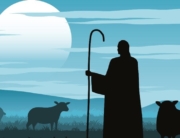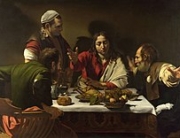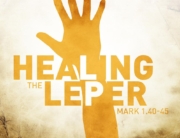Preacher: The Rev’d Dr Lynn Arnold AO
JESUS REALLY IS THE FORLORN HOPE
May the words of my mouth and the meditations of our hearts be worthy in your sight, O Lord, our Rock and our Redeemer. Amen.
It was just a week ago; the crowds thronged the street where he rode by on the back of a donkey. They strewed the path with fronds of palm and shouted out “Hosanna to the son of David”. What exultation there was that day. Surely the hard times were soon to be over as Jesus would overthrow the tables of the powerful just as he had upended the tables in the Temple.
But for all that joyous expectation, the following days didn’t fit the story. For someone who was going to overthrow the Romans and their local vassals, Jesus went about things in a funny way. On Monday, he left town to dine with friends in Bethany. And goodness knows where he was on Tuesday and Wednesday; maybe he was having private meetings with powers that be organising a transition of power but there were no rumours to that effect. By Thursday, however, we knew that he was back in town and that he had dinner with his leadership team. Of course, it was a Passover meal, but some thought that was just a ruse, that they were actually talking about how he was going to overthrow the oppressors. Then, after dinner, he and the team left to go outside the city gates to Garden of Gethsemane. Was this to be the start of an uprising? One of them at least was armed, though oddly enough Jesus told him to put the sword away – but maybe that was just a ruse, psychologically to disarm his opponents.
Anyway, if Jesus was plotting an overthrow, it was then that things really went off the rails for him. There in the Garden of Gethsemane, which means the Garden of the Olive Press, the authorities swooped and it was Jesus that was very soon pressed not the olives, let alone the powers that be. The next twenty four hours destroyed any final expectation there might have been that Jesus was going to succeed in taking over. “Hosanna to the son of David”! What a joke! Certainly he ended up in both the Chief Priest’s house and the Governor’s but not in the way his followers expected – not as master of both places, but as prisoner. Indeed some have noted how quickly his leadership team disappeared from the scene when they saw Jesus as captive not sovereign.
And all that led to that pathetic scene that took place on Friday afternoon – Jesus ‘King of the Jews’ there on a cross. On a crude and rough cross, just like all the other miscreants and dross of society. For the powers that be, it was a time when their smirks were plastered on their smug faces; once again they had crushed the opposition. And so, the crowds, feeling bitterly let down, turned on he upon whom they had placed so much hope only days before.
Jesus the Hope of the World – more likely Jesus the forlorn hope.
And so it would have seemed that Friday afternoon and all the following day until dawn on the Sunday. Jesus was simply just a forlorn hope; he had failed all the expectations of that previous Sunday.
But you know, if that was what they called Jesus – ‘the forlorn hope’ – they were actually right in ways they could not understand. For that weekend Jesus was indeed proven to be a forlorn hope.
Now before you start thinking that I am suggesting that you have just wasted your time through your Lenten deprivations and in your devotions this Holy Week, let me explain. For the concept of forlorn hope is not what you might think.
It turns out that the word ‘hope’ in forlorn hope is not the same as what we generally mean by ‘hope’. Our word ‘hope’ means to wait in expectation. The Spanish word for hope – ‘esperar’ – indeed means both to hope and to wait.
But the ‘hope’ in forlorn hope has an entirely different etymological meaning – it is not actually to wait in expectation at all. The phrase is an anglicisation of the Dutch ‘verloren hoop’ which literally translates as ‘lost troop’. Now that still sounds pretty hopeless, but the phrase actually has quite different significance that is not hopeless at all in its bigger sense.
I am sure that you will all have heard of the ‘advance guard’ in military tactics – the group of soldiers sent in advance of the main body of troops as they attack an enemy. Similarly, you will also have heard of the ‘rear guard’, those soldiers who hold the line as long as possible so that the main body can make a retreat.
Well in military strategy the advance guard are sometimes not the first troops into battle. Ahead of them may go, according to the Dutch, the ‘verloren hoop’ – those soldiers whose job it is to lay the ground for those that follow but will almost certainly die in the process. These ‘lost troops’ carry with them the hope of final victory even if they themselves are sacrificed for the greater cause. The concept has carried forward into English, but with the difference in meanings for ‘hope’ getting lost and confused over the centuries. In about 1600 John Dymmok’s ‘A Treatise of Ireland’ gave the following description:
Before the vantguarde marched the forelorn hope consisting of 40 shott and 20 shorte weapons, with order that they should not discharge until they presented theire peeces to the rebel breasts in their trenches, and that soddenly the shorte weapons should enter the trenches pell mell.
It goes without saying that, these sixty men almost certainly advanced to their death and by so doing enabled the advance guard that followed them and then the full body of troops after that to win the fight. They died but victory followed them.
So, with this understanding of ‘forlorn hope’, we can now certainly call Jesus a forlorn hope. Why? Because Jesus was sent into the world to proclaim God’s victory over a broken world. He was not sent as an advance guard nor as the main body of troops, but as the ‘forlorn hope’ – one who would die in the process. Jesus himself had noted his solitary forlorn hope role when, on the day of his trial, he said:
Do you think I cannot call on my Father, and he will at once put at my disposal more than twelve legions of angels? [Matthew 26:53]
And so it would be that, on that fateful Friday and the bleak Saturday that followed, the world would see Jesus as a ‘forlorn hope’ in the more commonly understood ‘hopeless case’ sense of the word; but then on the Sunday, the true meaning of ‘forlorn hope’ would be revealed. For Jesus had willingly gone to his death but had come out the victor.
So, while a week earlier, the crowds of Jerusalem had cried out ‘Hosanna to the son of David’, now the great cloud of witnesses in Heaven proclaimed ‘Hosanna to the Son of God’.
What had happened there? At one level a pretty amazing miracle – another dead person comes to life; Jesus’ followers of the day had seen something similar happen with his friend Lazarus a few weeks before. But this was much more than that. With Lazarus, Jesus went to the tomb, rolled the stone aside to the horror of the waiting crowd who had expected the stench of death to overpower them, but instead he proved the finality of death as a living Lazarus walked out with him. But this time, when the stone was rolled aside the tomb was empty – something we recall by the way with the symbolism of hollow Easter eggs – they are hollow because they remind us that there was nothing inside the tomb at Golgotha when the stone was rolled aside.
So, yes, it was a miracle – but it was much more that. For when the stone was rolled away and it was revealed that the body was not there, the word ‘miracle’ short changed the subject.
The latest issue of the New Scientist has an article promoted on its front cover as ‘Reality is real … we’ve just been looking for it in the wrong place’. I’ve read the article and it’s quite mind-bending with its treatment of quantum physics and the theories of the physicist David Bohm, none of which is particularly relevant here. But the title is very apt. There, on Palm Sunday, the crowd had shouted ‘Hosanna to the son of David’ expecting an earthly victor. But, in truth, they had been looking for reality in the wrong place. And it would not be until the following Sunday, today in our remembrance, that humanity would find reality in the right place – Hosanna to the Son of God. For what had been proven by the absence of the body of Jesus in the tomb was the existence of this world in the context of God’s Eternity. The death of this world had been defeated by the life of Eternity.
It is an easy trap to fall into to think of Eternity in a linear way. In other words to believe that we live our time-bound lives and then, when we die, we encounter Eternity. But, if Eternity is truly time-less, then it simply cannot come after time. It must exist timelessly alongside of all time – past, present and future. In other words, not only will Eternity exist at some future point, it exists now – it touches us here and now. Why else would Jesus have said to the repentant thief on the cross – ‘I tell you the truth, today you will be with me in Paradise’ [Luke 23:43]. Jesus could nominate a time within timelessness – today you will be with me in the timelessness of Paradise.
There is enormous significance to this for two reasons. Firstly that our celebration today of ‘Christ is risen – He is risen indeed!’ is not simply an historical commemorative fact, but a contemporary reality. Christ’s riseness is as real, as current this day as it was two thousand years ago. His crossing the divide by means of death from our time-bound world two thousand years ago was into an Eternity which touches our time simultaneously today just as much as it did then. And so too, his resurrection, coming back into our time-bound world is more than just a past tense idea, it is a present tense idea. And the meeting point between the two realms, the time-bound and the timeless, is the Holy Spirit.
The second point of significance is a personal challenge to each and every one of us. Let me show you this icon of the Cross – it is from a Romanian church. It may be difficult for you to see it from where you sit, but it consists of three crosses, not one. I bought it when we visited Romania some years ago and noticed something unusual about some of the graves in a graveyard there. In our graveyards it is not uncommon to see single crosses on graves. Such crosses are a beautiful testimony to the saving grace of salvation offered to each of us through Jesus’ death and resurrection.
But the three crosses on a Romanian grave ask something more. Three crosses on a grave remind us that, at the point of death, we are asked the most profound of questions. At that moment, when we seek to cross over into Eternity, there is no more profound question we will ever have faced in our lives than the question – ‘which thief am I?’ For surely, no matter how good or meritorious we may have believed our living to have been, at our dying we cannot hope to deny our brokenness. Compared to the perfection of the Son of God, nailed to a cross next to us, we can never expect ourselves to have been any better than a thief.
And so, at that moment when we depart the timefulness of this world to the timelessness of Eternity, we are each to ask ourselves: ‘which thief am I?’ The one on one side of Christ or the one on the other? The repentant thief or the unrepentant?
The Resurrection that we celebrate today is proof that God desires that all should come into his glorious presence, into his eternity; but it is also a reminder that it is we who must individually decide whether to accept or reject the God’s invitation delivered through his Son.
‘Hosanna to the son of David’ was cried out by the crowd on Palm Sunday. Today the cloud of witnesses proclaim ‘Hosanna to the Son of God’ – are we part of the crowd or the cloud?





